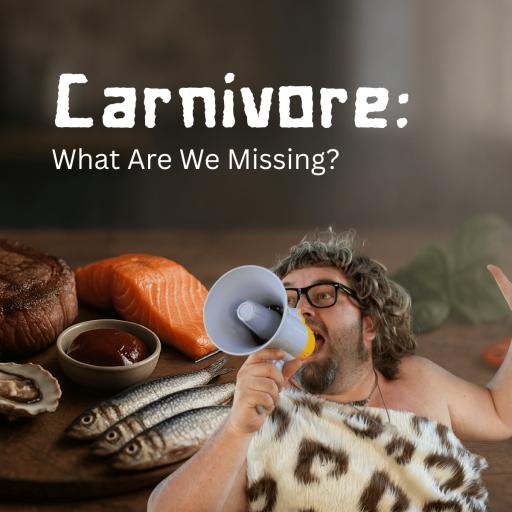Carnivore: What Are We Missing?
Balancing the benefits of an all-meat diet with strategies to cover nutritional gaps.

The all-meat carnivore diet has gained followers for its simplicity, satiety, and potential to reduce symptoms from autoimmune triggers, irritable bowel syndromes, or food intolerances. Many feel better quickly when they remove processed foods, refined carbs, and plant foods that cause digestive upset. But in removing entire food groups, we also remove certain nutrients and compounds the human body has adapted to use. This is not automatically harmful, but it changes the nutritional landscape. The key is knowing what may be absent and how to fill those gaps without abandoning the core idea.
Fiber and the Gut Microbiome
A strict carnivore plan contains virtually no dietary fiber. That means fewer fermentable carbohydrates for gut bacteria to turn into short-chain fatty acids (SCFAs) like butyrate, which support colon health, regulate immune function, and influence metabolic signaling. While the body can adapt, some people notice changes in bowel habits and microbiome diversity. Organ meats, collagen, and connective tissue provide glycosaminoglycans and gelatin, but they are not fiber substitutes. Adding even a small amount of low-irritant plant matter (e.g., zucchini, peeled cucumber) can help restore fermentation substrates.
Micronutrients at Risk
Carnivore can provide high amounts of B12, zinc, selenium, iron, and fat-soluble vitamins (A, D, K2 if certain foods are included). What’s harder to get without plants: vitamin C, folate, magnesium, potassium, and manganese. B1 (thiamine) can run low with very high meat intake and minimal carbohydrate, especially without organ meats. Iodine may be low unless seafood or iodized salt is consumed. Calcium intake may be insufficient without dairy or fish bones.
| Likely Gap | Animal Sources | Possible Workaround |
| Vitamin C | Liver, kidney, raw fish | Small citrus or bell pepper servings if tolerated |
| Folate | Liver, egg yolks | Incorporate organ meats weekly |
| Magnesium | Shellfish, fish | Supplement or include pumpkin seeds if tolerated |
| Potassium | Clams, salmon | Add avocado or leafy greens if tolerated |
| Iodine | Seaweed, fish, dairy | Seafood rotation or iodized salt |
| Calcium | Dairy, fish with bones | Bone-in sardines or fortified dairy |
Phytonutrients and Antioxidants
Plants supply thousands of bioactive compounds—polyphenols, carotenoids, flavonoids—that may protect against chronic diseases. Their absence means relying more on internal antioxidant systems and animal-based compounds like taurine, creatine, and carnosine. These have protective effects, but they are not identical in function to plant-derived molecules.
Electrolyte and Hydration Shifts
Low-carb and carnivore diets increase sodium and water loss through reduced insulin levels. Without replenishment, fatigue, headaches, or muscle cramps can occur. Salt to taste and include potassium- and magnesium-rich animal foods.
Blood Markers to Watch
LDL-C may rise substantially in some people, even when triglycerides improve. Uric acid can rise, and kidney stone risk increases in those with a predisposition. T3 thyroid hormone can drop slightly, often without symptoms, but should be monitored in those with thyroid disease.
| Red Flag | What It Can Mean | What to Adjust |
| Constipation | Low fiber or dehydration | Increase fluids, add tolerated low-FODMAP plants |
| LDL-C spike | Hyper-responder lipid phenotype | Adjust fat sources, monitor labs |
| Muscle cramps | Electrolyte loss | Increase sodium, potassium, magnesium |
| Low energy in training | Glycogen depletion | Add targeted carbs pre-workout |
| Recurring gout flares | High purine load | Limit certain meats, increase hydration |
Performance and Glycogen
Athletes in glycogen-demanding sports may notice reduced high-intensity performance without strategic carb intake. For strength training and low-intensity work, adaptation can be sufficient, but sprint and power output can lag.
Social and Practical Factors
Eating exclusively animal foods can limit dining options and increase costs. Long-term adherence data is minimal, so ongoing monitoring is sensible.
Practical Bridges
Carnivore can be kept nutrient-rich by rotating organ meats, shellfish, and dairy (if tolerated). For those who want near-zero plant exposure, supplementing key vitamins and minerals may help. Others may benefit from an “animal-first” approach that allows carefully chosen plant foods to address gaps without returning to a high-carb diet.
A lab panel every 6–12 months, including lipids, iron studies, uric acid, vitamin D, thyroid, and metabolic markers, can catch issues early. Adjustments can be small—adding seafood twice a week or including 100 grams of low-irritant plants daily—while still keeping most of the benefits people seek in carnivore eating.
Bottom Line
Carnivore can be a useful elimination tool or long-term approach for some, but awareness of what’s missing allows smarter planning. Whether you stay strict or add strategic foods, understanding the gaps is the difference between just removing plants and building a truly sustainable diet.
Updated: August 13, 2025 10:19
Category: Nutrition
Keywords: carnivore diet nutrient deficiencies gut health vitamin C sources animal-based nutrition
References
1. Slavin JL. “Fiber and Prebiotics: Mechanisms and Health Benefits.” *Nutrients* (2013). https://pmc.ncbi.nlm.nih.gov/articles/PMC3705355
2. Burén J, Ericsson M, Damasceno NRT, Sjödin A. “A Ketogenic Low-Carbohydrate High-Fat Diet Increases LDL Cholesterol in Healthy, Young, Normal-Weight Women: A Randomized Controlled Feeding Trial.” *Nutrients* (2021). https://pubmed.ncbi.nlm.nih.gov/33801247
3. Acharya P, Acharya C, Thongprayoon C, et al. “Incidence and Characteristics of Kidney Stones in Patients on Ketogenic Diet: A Systematic Review and Meta-Analysis.” *Diseases* (2021). https://pubmed.ncbi.nlm.nih.gov/34070285
4. NIH Office of Dietary Supplements. “Vitamin C — Health Professional Fact Sheet.” (updated regularly). https://ods.od.nih.gov/factsheets/VitaminC-HealthProfessional
5. NIH Office of Dietary Supplements. “Iodine — Health Professional Fact Sheet.” (updated Nov 5, 2024). https://ods.od.nih.gov/factsheets/Iodine-HealthProfessional
Comments
You must log in to post a comment.